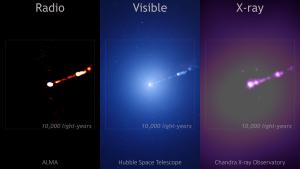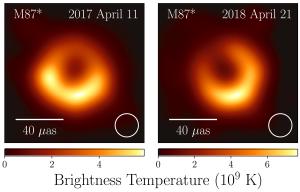Blog
Spot the Difference
19 January 2024
 NASA’s Scientific Visualization Studio/M.SubbaRao & NASA/CXC/SAO/A.Jubett
NASA’s Scientific Visualization Studio/M.SubbaRao & NASA/CXC/SAO/A.JubettFifty-five million light years from Earth there is a massive elliptical galaxy known as Messier 87, or M87 for short. It was cataloged by Charles Messier in the 1700s, along with 102 other fuzzy objects in the sky that were definitely not comets. It was confirmed to be a galaxy in the early 1900s, and by the mid-twentieth century, it was known to be a powerful radio source. But these days it is most widely known for the supermassive black hole deep in its core. Called M87*, it is the first black hole directly observed by astronomers. The first image of M87* was released in 2019, and was based on observations taken by the Event Horizon Telescope (EHT) in 2017. Now a new image based on 2018 data has been released.1 The similarities and differences between the two images tell us a great deal about M87* and black holes in general.
Although the Event Horizon Telescope has a single name, it is actually a collaboration of radio telescopes across the world. The observations of each observatory are combined through a process of interferometry to create an Earth-sized virtual telescope. Although the name stays the same, the EHT has improved over time with the addition of new equipment and even new telescopes. For example, the 2018 data included the Greenland Telescope (GLT), which did not participate in the 2017 run.
 The EHT Collaboration
The EHT CollaborationBecause of this change between different data runs, each run is effectively a new observation with a new telescope. Since the 2017 and 2018 data sets are theoretically uncorrelated, astronomers can compare the two to see which features of the black hole have remained the same, and which have changed.
One major similarity is that the size of the central shadow is the same for both images. This shadow is caused by background light from the center of M87 being focused toward us by the black hole. Since the size of the shadow depends on the size of the black hole’s event horizon, this confirms that the original estimation of the black hole’s size and mass was correct and that it hasn’t changed over time. This is important because there was some criticism that the original image relied too heavily on simulations to pull out its features from the data. We can now verify that the EHT imaging software is correct. We really can observe black holes directly.
One interesting difference easily seen in the images is that the bright region of the ring has shifted counterclockwise by about 30 degrees. This is due to the accretion disk of the black hole. As the disk swirls around the black hole, its orientation wobbles, the bright spot of the ring to shift. Astronomers predicted this effect, now confirmed by the data. The amount of shift over the course of a year is consistent with the predicted orientation of the black hole’s rotation, which should have its rotational axis aligned along the powerful jet that streams away from M87.
Taken together, these initial results confirm both the mass and rotation of M87*, which are its two fundamental quantities. Further analysis of the data will help astronomers understand how magnetic fields and turbulent plasma flows within the accretion disk interact. And we are still in the early stages of observing black holes. The planned next-generation EHT (ngEHT) program will add additional telescopes and detectors capable of higher-resolution images at a greater range of frequencies. Within the next decade, we may even have videos showing how M87* evolves over time.
The EHT Collaboration. “The persistent shadow of the supermassive black hole of M 87.” Astronomy & Astrophysics 681 (2024): A79. ↩︎